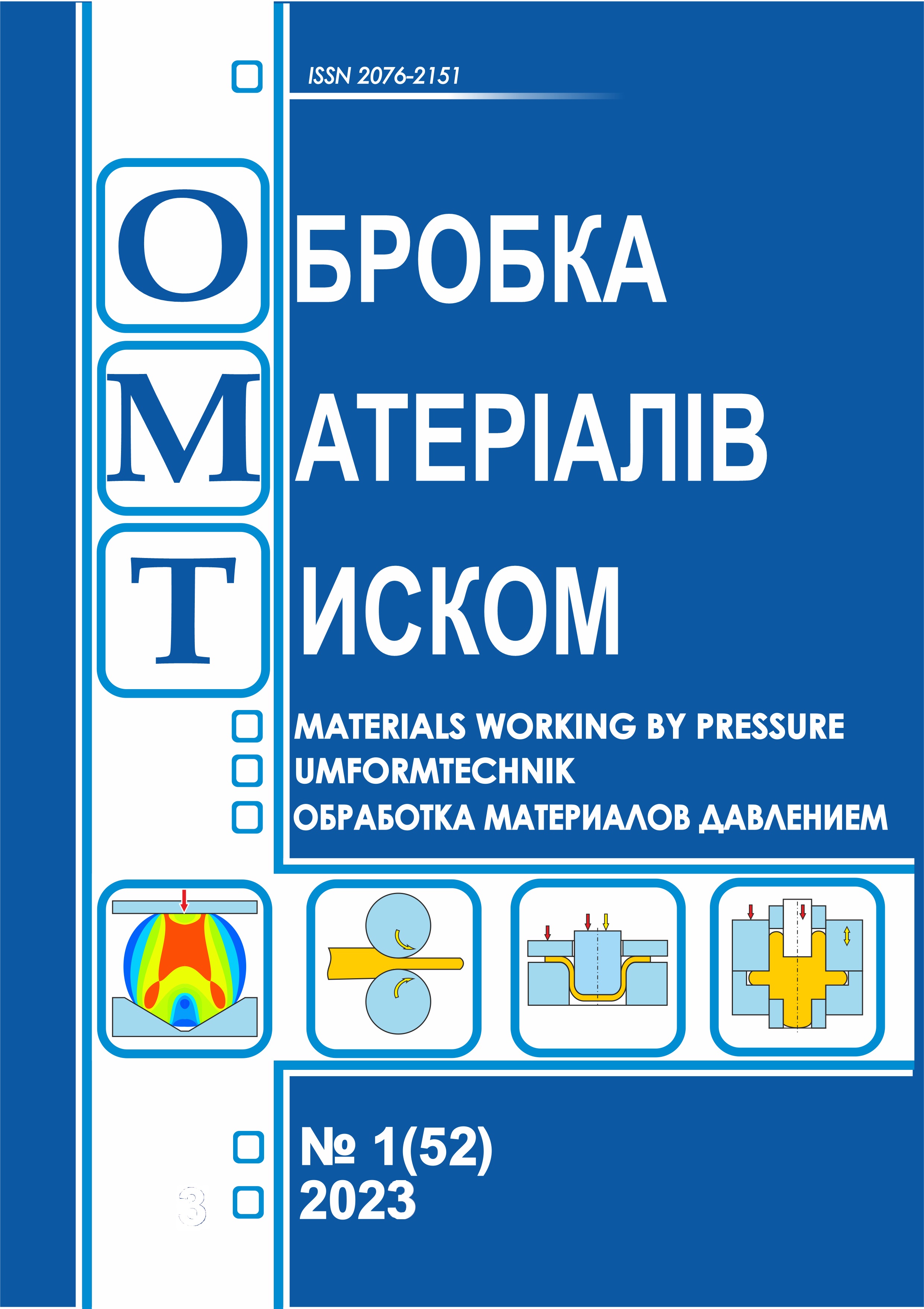Cast-shaped architectures formed by methods of intensive plastic deformation
DOI:
https://doi.org/10.37142/2076-2151/2023-1(52)50Keywords:
Lithomimetic, architecture materials, severe plastic deformation, high pressure torsion.Abstract
Beigelzimer Y., Kulagin R., Estrin Y., Davydenko O., Dmytrenko V. Cast-shaped architectures formed by methods of intensive plastic deformation.
One of the most effective concepts of modern materials science - materials with internal architecture (architectured materials), consists in the maximum possible use of those reserves that the structure of the material provides for the formation of its properties. The article describes a new approach to the creation of such materials, based on the fact that compositions of different metals are subjected to high shear under high pressure. For this, the currently well-developed methods of severe plastic deformation (SPD) are used: torsion under high pressure, equal channel angular pressing, twist extrusion, etc. Researchers have shown that SPD treatment leads to a strong connection of the components of the composition with each other and the controlled formation of multiscale structures in it. At the lower scale level, nanostructures are created, the main element of which is non-equilibrium high-angle grain boundaries with a thickness of about 1 nm. At intermediate scale levels, with a characteristic element size of the order of 1-100 μm, mesostructures are formed similar to those observed in the earth's lithosphere: folds, boudins, vortex structures, kink bands, shear bands, etc. Hence the name of the new approach - litomimetics. There is reason to believe that this way can be used to create new materials with high fracture toughness and properties that are usually not combined together, for example: high strength, high plasticity, low Young's modulus, low density, good biocompatibility, etc.
References
Ashby M. Designing architectured materials. Scripta Materialia. 2013. 68. рр. 4-7. DOI: https://doi.org/10.1016/j.scriptamat.2012.04.033
Architectured Materials in Nature and Engineering. Archimats. Estrin Y., Bréchet Y., Dunlop J., Fratzl P. Eds. Springer Nature, Switzerland AG. 2019. 445 р.
Beygelzimer Y., Kulagin R., Fratzl P., Estrin Y. Earth’s Lithosphere Inspires Materials Design. Advanced Materials. 2020. 33 (3). р. 2005473. DOI: https://doi.org/10.1002/adma.202005473
Haakon Fossen. Structural Geology. Cambridge University Press, Cambridge. 2010. 463 p.
URL:https://www.reddit.com/r/geologyporn/comments/68uqiu/softsediment_deformation_within_seismogenic/
Rice J. R. The Localization of Plastic Deformation. Proceedings of the 14th International Congress on Theoretical and Applied Mechanics, Delft, Netherlands, 30 Aug 1976. рр. 207-220. https://www.osti.gov/servlets/purl/7343664
Nadai A. L. Theory of Flow and Fracture of Solids, Vol. 2. New York: McGraw-Hill Book Company Incorporated. 1963. 705 p.
Ziegler H. An Introduction to Thermomechanics. Elsevier North-Holland, Amsterdam, Netherlands. 1983. 370 р.
Han J-K., Herndon T., Jang J., Langdon T. G., Kawasaki M. Synthesis of Hybrid Nanocrystalline Alloys by Mechanical Bonding through High-Pressure Torsion. Advanced Engineering Materials. 2020. 22 (4). Р. 1901289. DOI: https://doi.org/10.1002/adem.201901289
Estrin Y., Beygelzimer Y., Kulagin R. Design of Architectured Materials Based on Mechanically-Driven Structural and Compositional Patterning. Advanced Engineering Materials. 2019. 21 (9), p. 1900487. DOI: https://doi.org/10.1002/adem.201900487
Beygelzimer Y., Kulagin R., Estrin Y., Severe Plastic Deformation as a Way to ProduceArchitectured Materials. / Architectured Materials in Nature and Engineering. Estrin, Y., Bréchet, Y., Dunlop, J., Fratzl, P. Eds. Springer Nature, Switzerland AG. 2019, рр. 231-255.
Kulagin R., Beygelzimer Y., Bachmaier A., Pippan R., Estrin Y. Benefits of pattern formation by severe plastic deformation. Applied Materials Today. 2019. 15, рр. 236-241. DOI: https://doi.org/10.1016/j.apmt.2019.02.007
Kulagin R., Beygelzimer Y., Ivanisenko Yu., Mazilkin A., Straumal B., Hahn H. Instabilities of interfaces between dissimilar metals induced by high pressure torsion. Materials Letters. 2018. 222, рр. 172–175. DOI: https://doi.org/10.1016/j.matlet.2018.03.200
Pouryazdan M., Kaus B.J.P., Rack A., Ershov A., Hahn H. Mixing instabilities during shearing of metals. Nature Communications. 2017. 8. 1611. DOI: https://doi.org/10.1038/s41467-017-01879-5
Kulagin R., Beygelzimer Y., Ivanisenko Y., Mazilkin A., Hahn H. Modelling of High Pressure Torsion using FEM. Procedia Engineering. 2017. 207, рр. 1445-1450. DOI: https://doi.org/10.1016/j.proeng.2017.10.911
Kulagin R., Beygelzimer Y., Ivanisenko Y., Mazilkin A., Hahn H. High Pressure Torsion: from Laminar Flow to Turbulence. IOP Conference Series: Materials Science and Engineering. 2017. 194. 012045. DOI: https://doi.org/10.1088/1757-899X/194/1/012045
Cao Y., Wang Y. B., Figueiredo R. B., Chang L., Liao X. Z., Kawasaki M., Zheng W. L., Ringer S. P., Langdon T. G., Zhu Y. T. Three-dimensional shear-strain patterns induced by high-pressure torsion and their impact on hardness evolution. Acta Materialia. 2011. 59, рр. 3903-3914. DOI: https://doi.org/10.1016/j.actamat.2011.03.015
Bouaziz O. Geometrically induced strain hardening. Scripta Materialia. 2013. 68 (1), рр. 28-30. DOI: https://doi.org/10.1016/j.scriptamat.2012.08.008
Beygelzimer Y., Estrin Y., Kulagin R. Synthesis of Hybrid Materials by Severe Plastic Deformation: A New Paradigm of SPD Processing. Advanced Engineering Materials. 2015. 17 (12), pр. 1853-1861. DOI: https://doi.org/10.1002/adem.201500083
Cherepanov G.P. Fracture mechanics of composite materials. Moscow: Nauka, Main editorial office of physical and mathematical literature. 1983. 296 p. (in Russian).
Fitzgerald A.E., Kingsley C., Umans S.D. Electric Machinery. Sixth Edition. McGraw-Hill series in electrical engineering. Power and energy. McGraw-Hill Higher Education, A Division of The McGraw-Hill Companies. 2003. 703 p.
Brechet Y., Embury J.D. Architectured materials: Expanding materials space. Scripta Materialia. 2013. 68 (1), рр. 1-3. DOI: https://doi.org/10.1016/j.scriptamat.2012.07.038
Fujioka T., Horita Z. Development of High-Pressure Sliding Process for Microstructural Refinement of Rectangular Metallic Sheets. Materials Transactions. 2009. 50 (4), pp. 930-933. DOI: https://doi.org/10.2320/matertrans.MRP2008445

